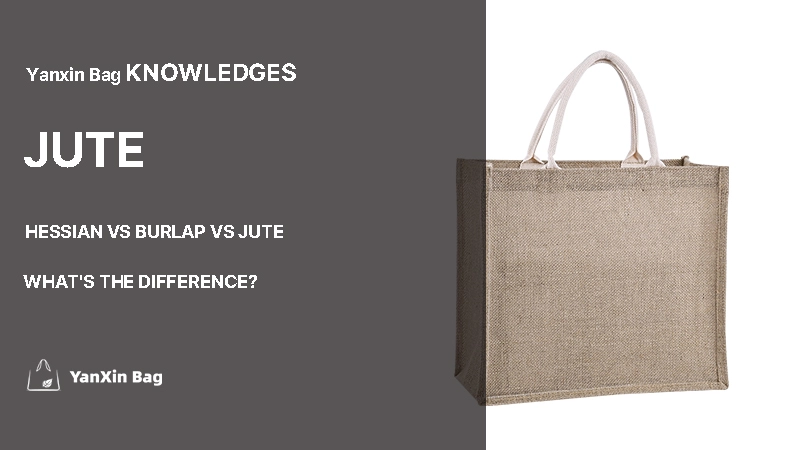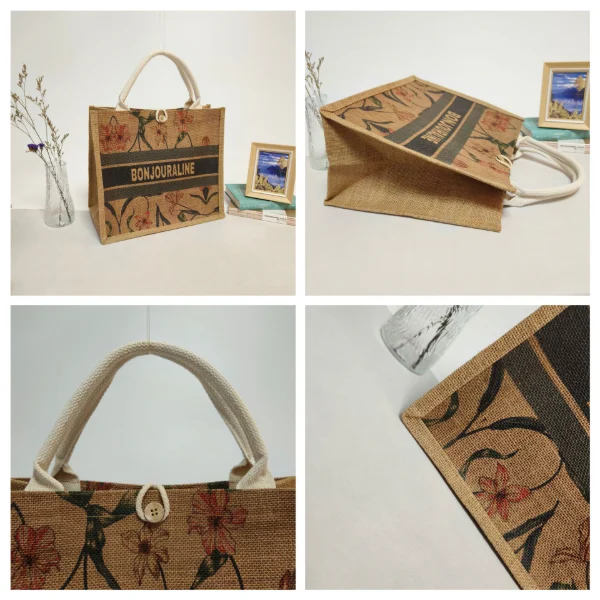Our Academy

Confused about the difference between jute, burlap, and hessian? You’re not alone—these terms are often used interchangeably, leaving buyers unsure about which material best suits their needs.
What’s the difference between jute, burlap, and hessian? Jute, burlap, and hessian all come from the same natural jute fiber, but their names and common uses differ by region. Jute refers broadly to the fiber and products made from it, including all types of jute bags. Burlap and hessian are actually the same material—woven jute fabric—used for packaging and construction. The term hessian is commonly used in Europe and Australia, while burlap is preferred in North and South America. Both burlap and hessian are biodegradable, reusable, and ideal for coffee sacks, agricultural bags, and eco-friendly packaging. Understanding these differences helps businesses choose the right jute-based material for their branding and sustainability needs.
While we’ve covered the shared origins, naming differences, and primary uses of jute, hessian, and burlap, choosing the right type of jute bag still depends on your specific needs and application scenarios. Keep reading to better understand how these natural materials are used across regions—and how to select the best option for your business.
Jute is a natural plant fiber mainly grown in India, Bangladesh, and parts of Southeast Asia. It is eco-friendly and biodegradable1, making it a popular choice due to its fast growth, low cost, and sustainability.
After processing, jute can be turned into fabrics of different qualities and uses, with Hessian and Burlap being the two most common types.
Hessian and Burlap are actually the same material, but their names differ due to historical and geographical reasons.
| Name | Main Usage Regions | Common Uses |
|---|---|---|
| Hessian | Europe, Australia | Premium packaging, coffee bags, decorative fabric |
| Burlap | North America, South America | Agricultural bags, construction sacks, coffee bean bags |
In Europe and Australia, people prefer the term Hessian, while in the U.S. and Canada, the material is more commonly called Burlap.
The word Burlap may originate from Middle English borel (meaning coarse fabric) or the Dutch word boeren (meaning farmer), indicating that this fabric was originally used for farmers’ clothing and daily items. By the 19th century, Burlap was widely used in American agriculture, especially for storing grain, coffee beans, and potatoes.
Jute has been used as a plant fiber since the 16th century, with Indian and Bangladeshi farmers weaving it into ropes and sacks. During the 19th-century Industrial Revolution, the British began large-scale jute cultivation in their colonies, establishing the first jute mills in Calcutta (now Kolkata, India), making jute an important global trade commodity3.
Jute Bags
Hessian/Burlap Bags

Different uses require different types of bags. Here are some recommendations:
If you need an eco-friendly shopping or gift bag, choose → Jute Bag (Hessian/Burlap material can be used)
If you need premium packaging or coffee storage, choose → Hessian/Burlap Bag
If you need a strong, low-cost, breathable bag for agriculture or construction, choose → Hessian/Burlap Bag
With the growing demand for sustainable products worldwide, more brands are adopting Jute and Hessian/Burlap as eco-friendly alternatives.
As people become more concerned about plastic pollution, jute fiber bags are emerging as a great alternative to plastic bags. Their environmental benefits include:
Biodegradable: Natural jute fiber decomposes within 1-2 years, leaving no harmful waste.
Sustainably Grown: Jute plants grow quickly and require minimal fertilizers and pesticides.
Reusable: Jute and Hessian/Burlap bags can be reused multiple times, reducing single-use plastic waste.
| Feature | Jute Bag | Hessian/Burlap Bag |
| Material | Pure jute | Pure jute |
| Texture | Soft | Medium |
| Thickness | Medium | Medium |
| Breathability | Moderate | Moderate |
| Durability | High | High |
Jute, Hessian, and Burlap are all derived from the same natural fiber, but their names and uses vary across different regions. Hessian and Burlap are essentially the same material, with different regional preferences for terminology. Jute, on the other hand, refers to the broader category of products made from jute fiber.
By understanding the distinctions and applications of these materials, you can make informed decisions when choosing the right bag for your needs, whether for fashion, packaging, or industrial use. As global demand for sustainable products grows, jute-based materials will remain a valuable and eco-conscious choice for a greener future.
Yanxin Bag offers a wide range of customizable jute, hessian, and burlap bags for businesses, promotions, and sustainable initiatives. We provide high-quality materials, personalized designs, and eco-friendly solutions to help elevate your brand.
Contact Yanxin Bag today for a free consultation and samples—let’s create the perfect eco-friendly bags for your business!
1 This link will help you understand the significance of biodegradable materials in reducing waste and protecting our planet.
2 Explore the versatility of Hessian fabric, its historical significance, and its modern applications in various industries.
3 Discover how jute transformed into a vital global trade commodity and its implications for international markets.
Answer: Jute is durable, biodegradable, and sustainable. It provides a natural, rustic look and serves as an eco-friendly alternative to plastic or synthetic bags.
Answer: Jute is a rapidly renewable resource that requires minimal water and fertilizers, making it one of the most sustainable bag options. However, if jute bags have a PE (polyethylene) coating, they gain water resistance but lose some eco-friendliness since PE is not biodegradable.
Answer: We offer various customization options, including different sizes, colors, handle styles, printing (logos, branding), and additional linings or coatings for durability.
Answer: Yes, pure Hessian and Burlap bags made from 100% jute fiber are compostable. However, if they have PE coatings or synthetic blends, they are not fully biodegradable.
Answer: Store jute bags in a dry, well-ventilated area, away from direct sunlight and moisture to prevent mold or weakening of the fibers.
Answer: Yes, jute fibers can be dyed, allowing for a range of colors. However, natural dyes are more eco-friendly.
Answer: Jute is the raw fiber, while burlap is a coarse woven fabric made from jute. The strength depends on the weave. In general, refined jute fabric can be stronger and more flexible than traditional burlap.
Answer: To keep jute bags in good condition, store them in a dry, cool place, and avoid folding them to prevent wrinkles and maintain their shape.
Answer: Jute is a natural, hypoallergenic material and is generally safe for those with sensitive skin or allergies. However, it’s always recommended to check for any personal skin reactions.
Answer: Jute bags can be repurposed for various uses, such as home decor, pet beds, gardening, or storage. Their durability and recyclability make them perfect for creative upcycling.

Order or no-order we are Always here to help you!
We will contact you within 1 working day, please pay attention to the email with the suffix “@yanxinbag.com”.
Order or no-order we are Always here to help you!
We will contact you within 1 working day, please pay attention to the email with the suffix “@yanxinbag.com”.